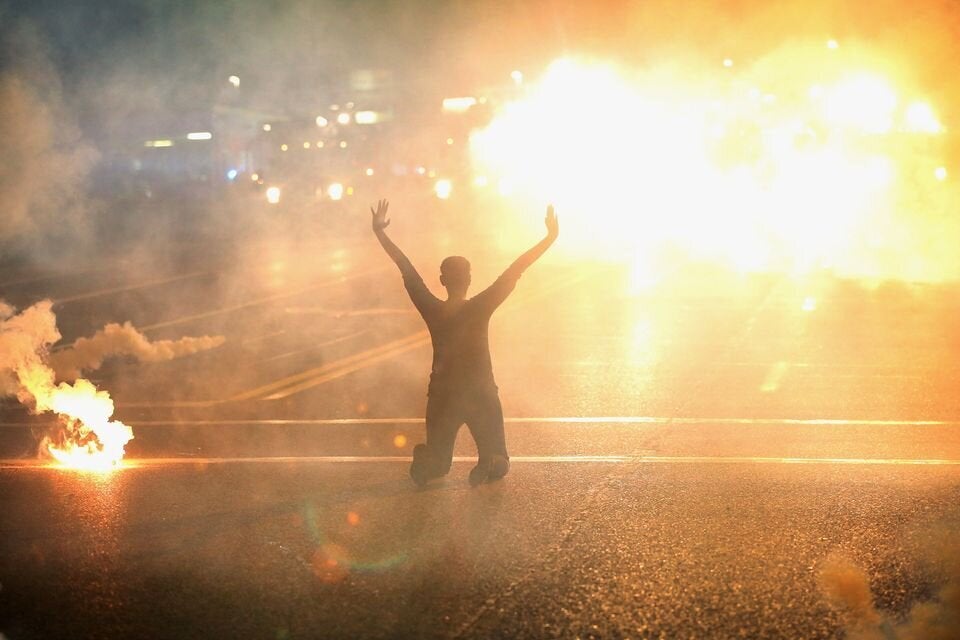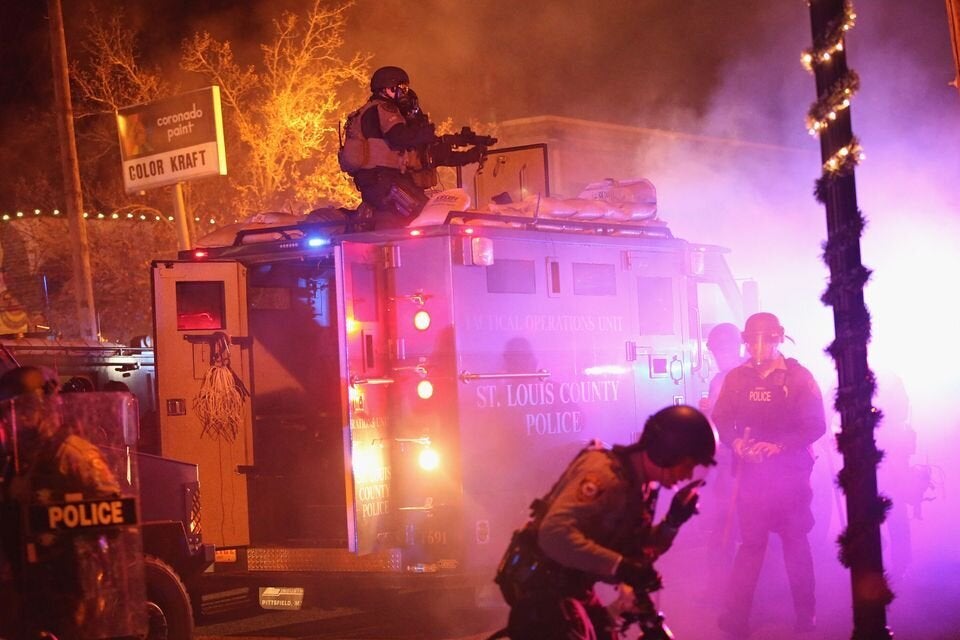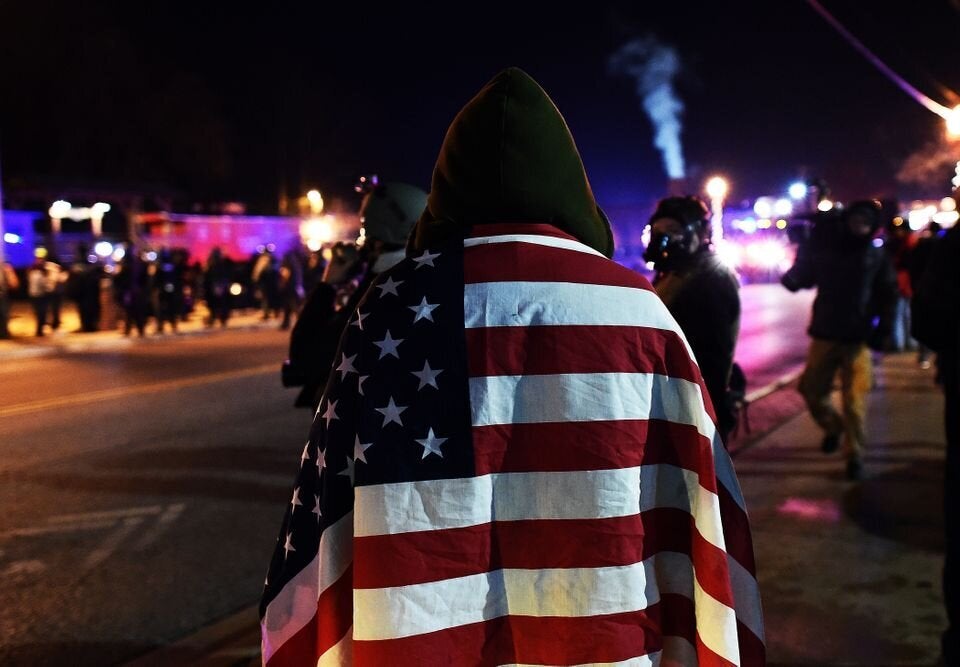August 9 marks five years since a white police officer, Darren Wilson, shot and killed an unarmed Black teenager named Michael Brown in Ferguson, Missouri. While accounts of exactly what happened vary, Wilson shot Brown at least six times ― twice in the head. Brown’s bloody body was left on a residential street for four hours in broad daylight.
Weeks of demonstrations, vigils and protests followed. These protests eventually turned into riots with militarized police officers on one side and fed-up Black residents on another. We then saw a conversation on race that rippled internationally and launched a movement for Black lives that continues today.
“Back in 2014, I was an elected official, I was an alderman in St. Louis City. My district office was right down the road from where Mike Brown was killed,” Antonio French, now a 40-year-old former alderman and current social entrepreneur, told HuffPost. “[Brown’s] body was on the ground when I arrived and I stayed out there for the better part of two months.”
He said, “I had no idea nor did anybody that it was going to get as big as it did or last as long as it did. The level of escalation on the part of law enforcement, we hadn’t seen anything like that.”

Peaceful demonstrations turned violent when police officers descended on the city dressed in camouflage, riot gear, Kevlar vests and gas masks. Officers were armed with military vehicles, rifles, tear gas, rubber bullets, real bullets and flash-bang grenades. Within a matter of days, the Missouri governor declared a state of emergency, a curfew was set, and the Missouri National Guard was deployed. During those late summer days, dozens of protesters were arrested and jailed.
Then a second wave of protests and unrest hit in November after a grand jury chose not to indict the police officer responsible for Brown’s death.
“At 25, I had to ask myself if [I was] OK with dying. Because there were so many instances where it was like, OK, we might not make it out of this.Johnetta Elzie, a Ferguson protester”
- Johnetta Elzie, a Ferguson protester
“I dealt with it day and night, all of the tear gas, all of the demonstrations, all of the late-night activity, even when it got violent and dangerous and destructive,” French said. “I found myself standing between property and looters, trying to keep things calm, trying to stand between police and angry crowds. I was arrested, I spent nights in jail. It was a very busy time.”
“The shit is traumatic,” recalled Johnetta Elzie, a now 30-year-old protester and writer. “At 25, I had to ask myself if [I was] OK with dying. Because there were so many instances where it was like, OK, we might not make it out of this motherfucker tonight. You’re constantly living in fear. And what kind of effect does this have on someone dealing with this all the time?”
It’s a valid question. That level of harrowing activism and exposure to violence can take a serious toll on the bodies and minds of protesters.
What happens to a human being during an event like Ferguson?
The Diagnostic and Statistical Manual of Mental Disorders, Fifth Edition, describes trauma as exposure to or experiencing the threat of death, serious injury or violence. It can occur when someone directly undergoes a traumatic event, witnesses it or learns of it.
“To be exposed to what we would call community violence, and then have the police basically take a military stance in the community, is absolutely a traumatic experience,” said Tammy Lewis Wilborn, a board-certified professional counselor and the owner and chief clinical officer of Wilborn Clinical Services in New Orleans.

Jennifer Sumner, a clinical psychologist and associate professor of psychology at the University of California, Los Angeles, added that experiencing the type of trauma that unfolded in Ferguson can also threaten a person’s sense of security.
“Being exposed to that kind of violence in your neighborhood would lead to people feeling very unsafe,” she said. “You’re protesting and you’re seeing people being attacked by police and other kinds of violence. That’s something we’d call an index trauma and that can trigger PTSD.”
And you don’t necessarily have to be present during the event to experience symptoms of post-traumatic stress disorder.
“We know that exposure to images of traumatic events, particularly through television or the internet, can trigger symptoms of PTSD,” said Sarah Lowe, a clinical psychologist and associate professor of social and behavioral sciences at Yale’s School of Public Health. “Other [medical professionals] have argued for an expanded definition that includes things like experiences of discrimination, microaggression, racism, sexism, homophobia, etc.”
Your body and brain are affected long after the initial trauma.
Exposure to trauma like police and community violence, racial discrimination and disenfranchisement, microaggression and constant images of destruction on the news can come with some serious ― sometimes life-threatening ― bodily repercussions.
“Quite a large body of evidence suggests that both trauma exposure and PTSD are associated with developing a wide range of physical health disorders down the line,” Sumner said. “Chronic diseases of aging like cardiovascular disease, like having a heart attack, having a stroke. Developing blood clots in your veins. All of these are associated with trauma and PTSD. [People are at risk for] developing diabetes, even dementia down the line.”
Activists’ physical health is also at risk in the near term.
“Now you’re out on the battlefield, and now we’re starting to see long-term things like migraines, high blood pressure, sleep disruption,” Wilborn said. “Particularly if people have seen certain things, they may be having flashbacks of certain experiences. Some people may have the startled response ― they’re shaking, they’re jumpy, they’re not calm in their body.”
Protesters in Ferguson faced the constant threat of tear gas, which can cause severe burning in the eyes and difficulty breathing and even internal bleeding and fractures if a person is hit by the canisters.
Prolonged exposure to such violence can have long-term effects on the psyche as well.
“You’re in a state that’s almost akin to a war zone.”
- Dr. Sarah Lowe on the Ferguson unrest
(Infographic by Simoul Alva)
“Someone who is very much affected by [the violence we saw in Ferguson] for three entire weeks or several months, you’re in a state that’s almost akin to a war zone,” Lowe said. “We know that people who experience that kind of trauma are at greater risk for depression, anxiety, suicidality, substance use, relationship problems, financial stressors.”
Elzie and French experienced a number of these health issues themselves.
“It was definitely a very stressful time,” French said. “I didn’t get a lot of sleep. You quickly become a target for people on Twitter, racists, people making death threats. I must have gotten two dozen death threats during that period. During Ferguson, I lost a lot of weight, and afterwards, I gained weight. Before Ferguson, I did not have gray hair in my beard, but you look at me three months after Ferguson, it’s like, holy shit! Did I age, like, five years in three months?”
Elzie said the vitriol, in particular, that she faced in response to her activism made it difficult to take care of her mental and physical well-being.
“I was ripping and running, traveling and marching and speaking during all this time. [It] was way more taxing on my body than I thought it would be,” she said. “All that shit adds up. I had very high anxiety. [My doctor] was like you’ve got to make a change because you will have a health risk if you keep going at the pace that you are.”

Black trauma, of course, is nothing new.
Of course, the Black experience in America has long been fraught with trauma and physical and psychological violence. Black people and other people of color can feel the effects of mental and physical trauma without ever having been on the front lines of a protest.
“Here’s the thing: There’s this shared collective history with Black people called slavery. And now we understand slavery as a generational trauma,” Wilborn said. “That experience not only left an imprint in terms of social, political, cultural, financial and physical history, but it also left an imprint of trauma in the physiology and psychology of Black people.”
“After you turn off your activism ― let’s pretend that happens ― you’re still Black,” Wilborn continued. “You still have to deal with your own lived experience of the trauma that comes from your navigating life as a Black person in America. You don’t get to turn it off.”
The same systemic racism that can lead to trauma can also be a barrier to healing. There are very few mental health care providers of color, and Black people face many other cultural and financial roadblocks to getting proper treatment.
“When we go into these [medical] spaces to be helped, that help is presented with bias and prejudice. ... Therefore we’re not always getting the right exams, we’re not getting asked the right questions. We can’t always afford the treatment that we need. It becomes this perpetual cycle of trauma,” Wilborn said.
“This is a very long fight that we’re getting into. You have to pace yourself, take some time off, ... take care of your body, your health and all of that.”
- Antonio French, a Ferguson protester
Black lives and minds matter.
Since Brown’s death, many more Black men, women and children have been killed by police or died in police custody, including Eric Garner, Freddie Gray, Philando Castile, Tamir Rice and Sandra Bland.
Though Ferguson has dropped out of the national headlines, violence, death and racism continue to plague the city. In the five years since the unrest, at least six men connected to the protests have died, two from alleged suicide and all under suspicious circumstances that only add to the racial tension there.
Despite the risks to their physical and emotional health, French, Elzie and many other Ferguson protesters are continuing the work they started. Elzie, along with fellow Ferguson protester and Baltimore native DeRay Mckesson, launched a nonviolent civil rights campaign called This Is The Movement. French started publishing two online newspapers focusing on community life in St. Louis. Other Ferguson protesters have gone into public service or become involved in Black Lives Matter demonstrations across the country.
“Even with these health consequences, we can see the benefits of taking a stand because people are fighting for what they believe in and protecting people’s lives,” Sumner said. “I don’t think the answer is to stop altogether. It speaks to how critical it is to engage in self-care. As much fervor as you bring to the causes, you need to bring the same level of fervor to caring for yourself.”
“While you are out there protesting that Black lives matter, you should also prioritize your life. Your life matters.”
- Dr. Tammy Lewis Wilborn
Just last month, Missouri state Rep. Bruce Franks Jr. ― an activist and a protester during the Ferguson unrest ― announced that he’d be stepping down from the legislature to deal with his anxiety and depression.
Elzie and French have taken steps to care for their mental health in the years after Ferguson as well.
“I’ve started reaching out and actually going to therapy. That was very helpful,” Elzie said. “I’ve deleted Twitter and Facebook. I have limits as far as the things that trigger me and trigger my mental health. I love being with my friends, I love a good wine. I’m just trying to relax.”
For his part, French has taken some time to step back from public service.
“This is a very long fight that we’re getting into,” he said. “You have to pace yourself, take some time off, take a little vacation if you need, if you’re in this for a very long time. It’s just like a marathon. You’ve got to take your time, take care of your body, your health and all of that.”
The experts similarly stress the importance of looking after your body and brain and taking a break from working hard for the cause when you need it. That doesn’t make you any less of an activist.
“The struggle will continue whether you’re involved or not, but we also know while you are out there protesting that Black lives matter, you should also prioritize your life. Your life matters,” Wilborn said.
“You need to make sure that you put your own oxygen mask on first. If you’re not being good to yourself, you’re certainly not good to the community because we still need you. We need you in our families, we need you at work, we need you in relationships. If you die [from trauma and stress], where is the justice in that?”
Infographic by Simoul Alva for HuffPost.
If you or someone you know needs help, call 1-800-273-8255 for the National Suicide Prevention Lifeline. You can also text HOME to 741-741 for free, 24-hour support from the Crisis Text Line. Outside the U.S., please visit the International Association for Suicide Prevention for a database of resources.
